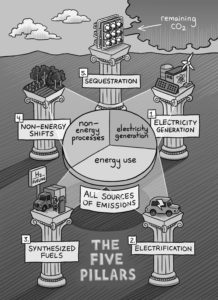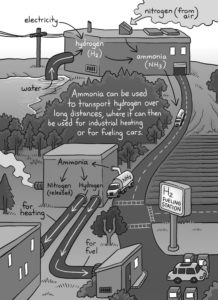A 100% Solution to Climate Change: Why is Ammonia Necessary?
By Solomon Goldstein-Rose on April 29, 2020
A guest post by Solomon Goldstein-Rose, author of the recently published book, The 100% Solution (Melville House).
It’s easy for people working on a particular technology or product to get overly focused on its wonderful promise. Sometimes we forget to consider whether or how our favorite idea fits into the larger issue.
Of course, nearly everyone reading this piece in Ammonia Energy will be heartily into the idea of green ammonia as an energy carrier in a zero-emissions world. But let’s keep things in context – is green ammonia one good idea, one possibility, or is it an absolute requirement of a full solution to climate change?
I looked at this question, not only for ammonia but for every category of technology, in the research and analysis project that became The 100% Solution, a recently published book. It lays out five “pillars” that constitute the physical minimum steps needed to solve climate change. (When I say “solve” I mean reach global net-negative emissions, the point at which impacts will start lessening rather than worsening.)
I arrived at those pillars by examining all the physical systems that emit greenhouse gases today and all the existing or proposed options for new systems that accomplish the same goals but don’t emit greenhouse gases. The goal was to find the places where we could say with certainty “this could never add up to more than x” or “this will absolutely be necessary for y.” Obviously, the faster the transition goes, and the more cheap clean equipment options are available, the better. But can we get there at all without a given category of policy, technology, or agricultural practice?
Here are the pillars I settled on:
- Electricity Generation. All fossil fuel power plants must be replaced with clean power plants (including fossil fuels with CCS where government will exists to mandate that extra cost). There are various options, the most likely to make large contributions being solar, wind, and nuclear. We need to expand electricity generation massively beyond current levels to power the rest of the transition. Given that scale, we probably need all clean generation options pushed to their fullest extent.
- Electrification. We must replace fuel-consuming equipment with electrified equipment in as many cases as possible – most notably cars, building heating, many trucks, some trains and ships, and some industrial processes. Electrified equipment tends to be more efficient, so once its capital costs drop through manufacturing scale-up, it will be cheaper.
- Synthesized Fuels. Not everything can be electrified – for instance, long-range ships and airplanes. Synthesizing some kinds of carbon-neutral (or carbon-free) fuels using clean electricity is an absolute necessity to getting all the way to a 100% clean energy system.
- Non-Energy Shifts. Industrial processes other than fossil fuel combustion that currently emit GHGs as byproducts must be replaced with new technological systems (or done with CCS). And agricultural practices must shift to reduce nitrous oxide and methane emissions and minimize deforestation.
- Sequestration. To close the gap to net-zero emissions and get into net-negative emissions, we must actively remove CO2 from the atmosphere. Growing forests and managing soils can affordably accomplish the first portion of needed sequestration, but direct air capture and possibly other technological methods will be needed to reach the required volume of sequestration each year.

If we fully carry out those five pillars, we will reach global net-negative emissions – and can do so by 2050, the IPCC deadline for hitting that point. If we fail on any one piece, we can be fairly certain we will not get all the way there.
So, is green ammonia essential, or icing on the cake?
Looking at pillars 3 and 4, it’s quite clear that green ammonia production is essential. There is next to no chance of solving climate change without it.
First, in pillar 4, the non-combustion processes in question include production of hydrogen for ammonia (fertilizer) synthesis. Fertilizer will still be required in a net-negative-emissions 2050, so producing that fertilizer without CO2 as a byproduct will be essential. No way around that.

And then, in pillar 3, we note that some processes can’t run on batteries or the grid and must have clean fuels. There’s nothing that says any of them absolutely must use ammonia, but delving into the role of synthesized fuels, it’s pretty clear that ammonia will play a role. For one, either ammonia or hydrogen can be used as the end fuel for road and ocean transportation (and some industrial processes) – and when they can be used, they’re likely to be cheaper per unit of energy than carbon-based fuels (synthetic, carbon-neutral diesel and such) because their synthesis doesn’t require the extra step of filtering CO2 from the air and disassociating the carbon and oxygen. And even if hydrogen is the end fuel, it will often make most sense to transport it as ammonia across large distances.
The case of long-range shipping alone points to at least some role for ammonia as fuel, because it should be cheaper than synthesized diesel. Unlike airplanes, ships don’t need quite the energy density of a carbon fuel so they can use the cheaper option. But they also can’t afford to sacrifice too much space to fuel storage so ammonia, being more energy-dense than hydrogen, will likely be the preferred choice.
All in all, green ammonia production is absolutely required as at least some portion of a 100% solution to climate change. And if the synthesis processes and end-use equipment become cheap enough, ammonia – or hydrogen transported as ammonia – could grow into an even larger role in the eventual energy system. The 100% Solution notes that synthesized fuels as a whole could address anywhere from 5% to 45% of the problem, depending how cheap they get. At least some of that will be ammonia.
A guest post by Solomon Goldstein-Rose, author of The 100% Solution (Melville House). The book’s Amazon.com Web page features a list of editorial reviewers who have commented on the book, including the New York Times Book Review, United States Representative Jim McGovern, and climate science pioneer James Hansen.